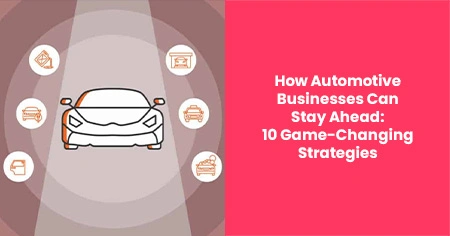To keep up, automotive businesses need to adapt and find better ways to serve their clients. This article will share ten practical strategies to help automotive businesses improve their operations, satisfy customers, and stay ahead in the market.
By implementing these ideas, businesses can navigate the evolving landscape effectively and achieve long-term success.
Simplify Vehicle Inspections with Digital Tools
Paper-based vehicle inspections can slow things down and lead to missed steps. Many shops are now switching to digital tools that make inspections easier, faster, and more consistent. These tools guide technicians through each part of the process while helping reduce human error.
One of the best ways is to use a structured checklist for vehicle inspection and keep everything on track. This practice gives your team a clear path to follow, so nothing important gets skipped. This leads to more reliable results and better communication with customers.
To make the most of digital inspections, some businesses also seek help from experts and set up systems correctly. With the right tools and guidance, your team can work more efficiently and deliver a higher level of service every time.
Solve Problems Faster with Repair Databases
Fixing car issues can take time, especially when the problem isn’t common. If your team guesses or tries different things without clear direction, it can lead to wasted hours and unhappy customers. Real-world repair databases make this process much easier. These tools store actual fixes used by other experienced technicians for the same problems.
Your team can look up these solutions, compare symptoms, and follow tested repair steps. This cuts down on trial and error and improves the speed and quality of your service. Even newer staff can follow the steps confidently and get better results.
Using a repair database also keeps your shop organized. Instead of looking through books or searching online forums, your team can find everything in one place. That means faster work, fewer mistakes, and more trust from every customer.
Stay in Touch with Automatic Follow-Ups
Most people won’t return to a shop they forget about. That’s why following up after service matters more than it seems. Automated follow-up systems help you stay connected without extra effort. They can send reminders for oil changes, brake checks, or upcoming service needs. They can also send quick thank-you notes or ask for reviews after a job is done.
This builds a better relationship between your shop and your customers. It shows them that you care, even after the bill is paid. That simple message can turn a one-time visit into long-term loyalty.
You also stay ahead of your schedule. If a system reminds people when to come back, it helps reduce last-minute calls and missed maintenance. The result? A steady flow of returning clients, stronger trust, and better shop planning — all with just a few clicks.
Give Clear Prices with Digital Estimates
One thing customers always want to know is, “How much will it cost?” If the answer isn’t clear, they may hesitate or go somewhere else. That’s why using digital estimates is a smart move. These tools break down the cost of parts, labor, and services in a simple way. The customer can see exactly what they’re paying for before work starts.
Digital estimates help avoid confusion. Everything is listed in a clean format, and updates can be shared quickly if the job changes. Your team doesn’t have to explain every small detail — the estimate does it for them.
This builds trust. When people see that you’re open about prices, they’re more likely to say yes. They feel confident that they’re getting honest service, which keeps them coming back.
Keep Your Team Sharp with Regular Training
Vehicles are changing fast. New features, smart systems, and electric models are becoming the norm. If your team doesn’t keep up, mistakes happen, and customers notice. That’s why regular training is key. It helps your staff stay updated and ready to handle newer models with confidence.
Training doesn’t always mean long courses or days off work. Many programs are online and can be done in short sessions. Even small updates can make a big difference in how your team works.
When your staff knows more, they work faster and make fewer errors. They also feel more confident and proud of their work. That energy shows in how they treat customers. A well-trained team isn’t just better at fixing cars — they help your business grow from the inside out.
Add EV Services to Stay Future-Ready
Electric vehicles (EVs) are showing up more in every neighborhood. They’re quiet, clean, and smart — and they need special care. If your shop only handles gas-powered cars, you could be missing out. Adding EV services is one of the smartest ways to prepare for the future.
You don’t need to change your whole setup. Start small — offer basic EV checks or train one team member first. Learn how to handle batteries, charging systems, and safety tools. Many car owners with EVs are still looking for local shops they can trust.
Being ready for these vehicles helps your business stand out. It also shows that you’re keeping up with changes in the industry. Customers notice when a shop moves with the times, and they’re more likely to choose you over others.
Listen to Customer Feedback and Use It Well
Every business says it cares about customers. But the ones that truly grow are the ones that listen. Feedback helps you see what’s working and what needs to change. It can come from online reviews, short surveys, or even quick chats at the counter.
Make it easy for people to share their thoughts. Ask simple questions after the service or send a short message a few days later. Most customers are happy to help if it takes only a minute.
What they say might show small issues your team missed — or reveal what they really loved. Use this input to fix weak spots and build on your strengths. When customers see that their feedback leads to changes, they feel heard. And when people feel heard, they come back.
Keep Parts Organized with Smart Inventory Systems
When a part is missing, everything slows down. Jobs get delayed, customers wait longer, and your team gets frustrated. That’s why having a good inventory system is important. It helps you track what you have, what you need, and when to order more.
Modern inventory tools show real-time updates. You can see which parts are low and which ones are moving fast. This saves time and cuts down on waste. It also helps avoid last-minute runs or holding on to parts you don’t need.
Keeping your stock organized means fewer mistakes and faster repairs. When your team has what they need, they stay focused. And when customers get their cars back on time, they trust you more. It’s a simple fix that brings steady results.
Make Payments Easy with Contactless Options
Customers expect fast and flexible payment methods. Long checkout lines or limited options can ruin an otherwise good experience. That’s why offering contactless payment is no longer a luxury—it’s something most people now look for. Whether it’s tapping a phone, paying online, or using a card without swiping, the goal is to make the process quick and smooth.
You can also send digital invoices or allow payments through customer portals. This works exceptionally well for those who are short on time or prefer to pay after leaving the shop. Adding a few simple options shows that your business is modern and convenient.
These changes improve how customers feel when they leave. A smooth payment process means they’re more likely to return, leave a review, or tell others about their good experience. That’s how small upgrades can drive steady growth.
Use Simple Tools to Boost Shop Efficiency
Small improvements in daily tasks can lead to big results. From setting job timers to using digital check-in forms, simple tools can make a big difference. These tools help your team stay on track, avoid confusion, and keep jobs moving without delays.
Even something like a shared team dashboard or task board helps everyone know what’s next. You don’t need to invest in complex systems. Many low-cost apps and platforms are available that do just enough to keep things organized and stress-free.
When your shop runs smoothly, both your team and your customers feel the difference. Less waiting, fewer mistakes, and more time to focus on quality repairs — all by adding a few smart tools into your routine.
Conclusion
Running an automotive business today takes more than just skill with tools. It takes smart choices, simple systems, and a team that’s ready to grow. The strategies shared in this article are easy to apply and can help any shop work better, serve faster, and stay ahead in a changing industry.








